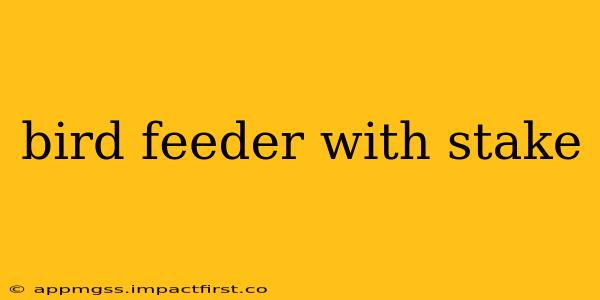Choosing the right bird feeder can transform your backyard into a vibrant avian sanctuary. A bird feeder with a stake offers a convenient and attractive way to provide food for your feathered friends, while keeping the feeder secure and accessible. This guide explores everything you need to know about bird feeders with stakes, helping you select the perfect one for your needs and garden.
What are the Benefits of a Bird Feeder with a Stake?
Bird feeders with stakes offer several advantages over hanging feeders or those designed for mounting on a platform. The most significant benefit is stability. A securely planted stake keeps the feeder upright, even in windy conditions. This prevents spills, keeps the food dry, and ensures birds can easily access the feed without struggling. The stake also elevates the feeder, providing better visibility for birds and deterring some ground-based predators like squirrels or raccoons. Finally, the staked design often leaves less visual clutter in your garden compared to hanging feeders.
What Types of Bird Feeders with Stakes are Available?
The market offers a variety of bird feeders with stakes, each designed to accommodate different bird species and feeding preferences. Here are a few popular types:
- Tube Feeders with Stakes: These are classic designs, featuring a transparent tube filled with seeds, often with perches for birds to land on. The stake provides stability and elevates the feeder.
- Hopper Feeders with Stakes: Hopper feeders offer a larger capacity, storing a significant quantity of seed. The enclosed design protects the food from the elements and keeps it fresh longer. The addition of a stake adds to its stability and elevates the feeding area.
- Suet Feeders with Stakes: Suet feeders are ideal for providing high-energy food to birds during colder months. Many suet feeders are designed to be mounted on stakes, ensuring easy access for birds.
How to Choose the Right Bird Feeder with a Stake?
Selecting the appropriate bird feeder involves considering several factors:
- Bird Species: Different birds prefer different types of food. Research the bird species common to your area and choose a feeder that caters to their dietary needs. For example, smaller birds may prefer tube feeders, while larger birds might prefer hopper feeders.
- Material: Metal, plastic, and wood are common materials for bird feeders. Metal is durable and weather-resistant, while plastic is more affordable. Wood offers a natural aesthetic but may require more maintenance.
- Capacity: Consider how many birds you typically see in your yard and choose a feeder with a capacity that can accommodate them. Larger feeders reduce the frequency of refilling.
- Stake Length: The length of the stake should be appropriate for your garden's conditions. Longer stakes are ideal for areas with taller vegetation or deeper soil. Consider the height you want the feeder at to ensure easy viewing and accessibility for the birds.
- Cleaning and Maintenance: Select a feeder that is easy to clean and maintain. Regular cleaning prevents the spread of disease among birds.
What is the best bird feeder to keep squirrels away?
While no bird feeder is entirely squirrel-proof, some designs are better at deterring them than others. Weight-activated feeders, those with cages or baffles around the food, or feeders with hanging features (requiring a higher degree of agility) are often more effective at keeping squirrels at bay. Placing the feeder further out in the open, away from trees or branches that squirrels can jump from, can also be helpful.
How high should I place my bird feeder with a stake?
The ideal height depends on several factors, including the bird species you attract, the surrounding vegetation, and predator activity. Generally, placing the feeder 4-6 feet above the ground is a good starting point. This height provides sufficient clearance for birds to feed comfortably while keeping it out of reach of some ground predators. However, you should observe the birds and adjust the height as needed.
How do I install a bird feeder with a stake?
Installation typically involves pushing or hammering the stake into the ground. Ensure the ground is soft enough and the stake is securely anchored to avoid tipping. If the ground is hard or rocky, you may need to dig a small hole first to facilitate installation. Always follow the manufacturer's instructions for the specific feeder model.
What kind of birdseed should I use?
The best birdseed depends on the types of birds you want to attract. Sunflower seeds are a popular choice as they appeal to a wide variety of birds. Niger seeds attract finches, while shelled peanuts are a favorite of jays and woodpeckers. Avoid using moldy or spoiled seed, as it can harm birds.
By carefully considering these factors and choosing the right bird feeder with a stake, you can create a thriving haven for birds in your backyard, bringing beauty and enjoyment to your outdoor space. Remember to regularly clean and refill your feeder to ensure the birds have a consistent source of nutritious food.
